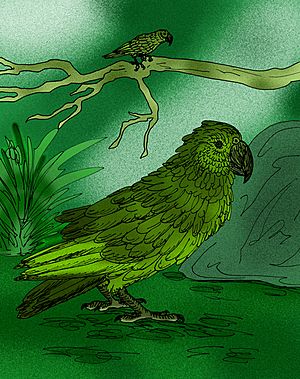Heracles inexpectatus facts for kids
Quick facts for kids Heracles inexpectatus |
|
|---|---|
 |
|
| comparison of H. inexpectatus and Nelepsittacus minimus | |
| Scientific classification | |
| Genus: |
Heracles
|
| Species: |
inexpectatus
|
Heracles inexpectatus was a huge parrot that lived a very long time ago. It's a fossil species, meaning we only know about it from its bones. This giant bird lived in New Zealand about 16 to 19 million years ago, during a time called the early Miocene epoch.
Scientists believe Heracles inexpectatus could stand up to 1 meter (about 3 feet) tall. It weighed around 7 kilograms (about 15 pounds)! This makes it the biggest parrot ever found. It was so big that some scientists nicknamed it "squawkzilla."
This amazing parrot probably couldn't fly. Its strong beak was perfect for cracking open tough foods, not just fruits and nuts. Like the kakapo, another large New Zealand parrot, Heracles might have used its powerful beak to climb trees. It shared its home with other parrots and many other birds.
Contents
Discovering the Giant Parrot
Scientists found the first bones of Heracles inexpectatus in 2008. The discovery happened in a place called Saint Bathans in Otago, New Zealand.
At first, the bones were thought to belong to a large eagle. But later, a student noticed that the bones looked different from typical eagle bones. This led to a closer look.
How it Got its Name
The name Heracles comes from an old Greek myth. In the story, the hero Herakles fought and defeated a king named Neleus. Another ancient parrot found in the same area was named Nelepsittacus, after King Neleus. So, naming this new, even bigger parrot Heracles seemed fitting!
The second part of its name, inexpectatus, means "unexpected." The scientists chose this name because they were very surprised to find such a huge parrot from the Miocene time.
What Heracles Was Like
Heracles inexpectatus was the largest parrot species ever known. It was much bigger than any modern parrot or cockatoo. Scientists estimate it was about 1 meter tall and weighed 7 kilograms.
Because of its size, scientists think it was a flightless bird. This means it walked on the ground and perhaps climbed trees instead of flying.
Island Giants
Sometimes, animals on islands grow much larger than their relatives on mainlands. This is called Island gigantism. New Zealand is famous for having many large, flightless birds, like the moa. Heracles inexpectatus is another great example of this. Before Heracles was found, the largest known parrot was the kakapo, which also lives in New Zealand and is flightless and nocturnal (active at night).
Where it Lived
The fossil bones of Heracles inexpectatus were found in a place that used to be a large freshwater lake. This area was a wet forest with many different plants, like cycads and palms. Many other bird species also lived there.
Heracles likely filled a special role in its environment. On islands like New Zealand, there weren't many large mammals. So, big birds like Heracles could grow large and take on roles that mammals might fill in other parts of the world.
Images for kids
See also
 In Spanish: Heracles inexpectatus para niños
In Spanish: Heracles inexpectatus para niños


